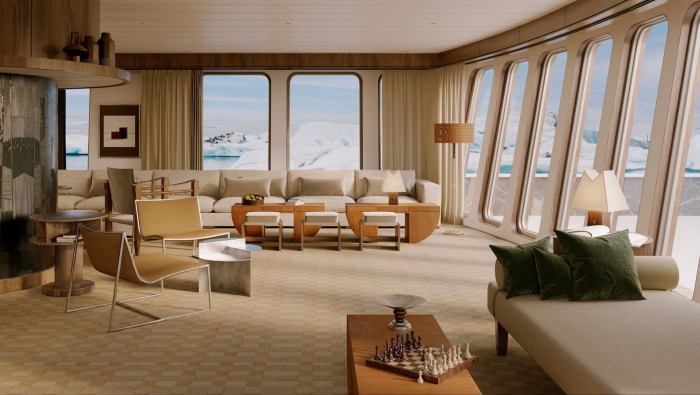Can a cruise ship be sustainable?

As a captain of cruise ships and commercial vessels in the polar regions for the past decade, Sophie Galvagnon had the thrill of exploring some of the most remote parts of the Arctic and Antarctica. But she couldn’t shake a growing sense of unease.
“I started to feel guilty being a captain on the ship, bringing more pollution . . . the smell of the fuel as you start the engine in front of a polar bear,” she says. And that’s if the ship even stopped to see the bear — often the crew would keep quiet if they spotted one, because offloading 200 passengers on to the ice in small groups would take too long.
The experience also seemed disconnected from what Galvagnon felt polar exploration should be about. Somewhere in the fixed itineraries, the vast groups of passengers and the huge carbon-heavy ships looming high above the water, the spirit of adventure had been lost.
While taking a break to figure out what to do next, she was sitting on the deck of a friend’s sailing boat in northern Norway when a whale appeared.
“It was completely silent and peaceful. She was so close that you could feel the humidity of her breath, the smell of plankton. Everyone was mesmerised,” she recalls. It had to be possible to recreate that kind of immersive, low-environmental-impact experience, she reasoned, but with a small cruise ship.


The result is Selar, a company founded by Galvagnon, which is building a new type of expedition cruise ship designed for the Arctic, with rigid sails fitted with solar panels. Designed to carry 36 passengers and 24 crew, it aims to be the first cruise ship powered by renewable energy and to create a new model for ultra-low-emission expedition vessels.
The five 35m-high sails are made of aluminium and can twist up to 180 degrees to catch the wind, or fold down when not required. The idea is that most of the time the ship will rely on the wind, or on solar energy that is captured and either used directly or stored in batteries to power the boat at a reduced speed. The engine will be used as little as possible, and will run on HVO fuel (a biofuel made from vegetable oil).
Galvagnon developed the concept with a naval architect, drawing inspiration from both historic exploration vessels and the latest technologies. The ship’s design was rigorously assessed on its ability to cope with extreme polar conditions (it will be able, for example, to withstand up to 44 tonnes of ice sticking to the sails). A retractable keel and water ballasts add stability, and the ship heels at a maximum angle of three degrees.

The Swedish-French daughter of a cargo ship captain, Galvagnon started her career on container ships before discovering a passion for the ice while working for a cruise line in Antarctica. She honed her ice navigation skills on icebreakers in Sweden, becoming the youngest woman to be decorated with the French Order of Maritime Merit.
With her co-founders, French entrepreneurs Julia Bijaoui and Quentin Vacher — founders of grocery delivery app Frichti — she secured financing from funds, family offices and private investors in the hospitality and tech industries. So far, the structural engineering work has been completed at a shipyard in Mauritius and the hull is being built, with the ship due to be ready in June 2026.
Beyond the design innovations, the aim is to have a more positive impact by supporting scientists, having a zero-waste policy at sea and with an initiative to collect plastic rubbish along the shores of Svalbard.
Cruise ship companies offering polar trips are under particular pressure to reduce their emissions, given the fragile environments they operate in, the rapid rise in passenger numbers and the fact that their clientele are paying specifically to see unsullied nature. The number of passengers visiting Antarctica by boat has risen from 37,000 in the austral summer of 2013/14 to 122,000 last year. The Association of Arctic Expedition Cruise Operators (AECO) says that, among its members, passenger numbers in the region increased from 33,000 in 2019 to 49,000 in 2023, though it says the growth over the past decade is now “levelling out”.
Since July, the International Maritime Organization’s Polar Code has prohibited the use of heavy fuel oil in Arctic waters, and the Norwegian government has introduced tighter environmental regulations in Svalbard that come into effect in January 2025. They include a ban on ships entering protected areas if carrying more than 200 passengers.
“The most damaging impact cruise ships have in the Arctic is the pollution they generate — air emissions, including black carbon, as well as water pollution including sewage, food waste and grey water from sinks and showers,” says Bryan Comer, head of the International Council on Clean Transportation’s marine programme.
Some operators have turned to liquefied natural gas (LNG) instead of marine gas oil or diesel to cut carbon emissions. Though this is promoted as a green solution, environmental groups have pointed out that such ships could actually have a bigger climate-change impact because of the methane released. Others have built hybrid-electric ships, which can switch between electric batteries and conventional fuel.


Selar isn’t alone in looking to rigid sails as a potential alternative. The Norwegian operator Hurtigruten and Marseille-based Ponant are both developing ships incorporating sails with built-in solar panels that are due to launch by 2030. Ponant is evaluating two different sail configurations but says 50 per cent of propulsion energy will be from wind power. Hurtigruten says its ship, designed to carry 500 passengers on its Norwegian coastal route, will have retractable wing-like sails, and reduce drag on the hull by emitting a stream of air bubbles.
Meanwhile, the French hotel group Accor and shipbuilder Chantiers de l’Atlantique have partnered to create the 220m-long, super-luxury Orient Express Silenseas. It will have a hybrid propulsion system running on LNG, but will benefit from wind power captured by three rigid sails on tilting 100m masts. It is due to be ready in 2026 and will sail with 130 passengers in the Mediterranean and Caribbean.
Cargo-ship operators are also experimenting with wind propulsion. Earlier this year, Cargill Ocean Transportation announced that over a six-month trial, the Pyxis Ocean had saved an average of 3 tonnes of fuel per day. The ship, a bulk carrier, had been retrofitted with two 37-metre-high steel and fibreglass ‘WindWings’ created by UK company BAR Technologies, based on designs used by sailing teams in the America’s Cup.
Comer says hybrid-electric vessels, which reduce reliance on fossil fuels, are a promising step forward, along with wind-assisted propulsion, more energy-efficient hull designs and sailing at a slower speed. “Cleaner fuels such as green hydrogen or green methanol could provide even bigger environmental benefits,” he adds.

He is less enthusiastic about cruise companies’ claims to raise awareness about climate change or conduct scientific research. “There is a risk of greenwashing,” says Comer. “What’s more valuable is cruise operators reducing their own environmental impact, rather than using science programmes as a PR tool.”
Galvagnon is also sceptical: “To me, it’s bullshitting to think you can raise awareness on a 200-passenger ship, where you drink champagne in a hot tub watching the ice.”
One problem with research on bigger ships is that they are always restricted by itineraries, she says, which means scientists end up going to the same areas and have limited time on the ground. By scrapping itineraries, Selar plans to take scientists where they really need data and to research stations, which tend to be in remote areas. She hopes clients will see the value of being on a ship that is “useful”, and will put their trust in the crew and guides: “It’s all about adventure, not ‘ticking boxes’.”
Passengers will be invited to the bridge to see the “backstage of expedition planning” for the day ahead — but there is flexibility to adapt, says Galvagnon. “If we see a polar bear, we will change course and see how we can approach . . . or if there is an incredible sunset at the end of the polar midnight sun, then we can drop the passengers on the ice and they can watch.”
Selar’s proposed rates start at €6,780 for a six-day whale-watching trip. Galvagnon hopes to grow the fleet to explore other parts of the world, including offering an alternative to the current options in Antarctica. “When you go there today it’s like Disneyland. There are all these huge ships within the small range of the [Antarctic] Peninsula. You have to book slots to go on land.”
For now, the focus is on the Arctic. By starting with some of the most extreme conditions on Earth, she aims to prove that a new model is possible: “If it works there, it could work anywhere.”
Find out about our latest stories first — follow FTWeekend on Instagram and X, and subscribe to our podcast Life and Art wherever you listen
#cruise #ship #sustainable




